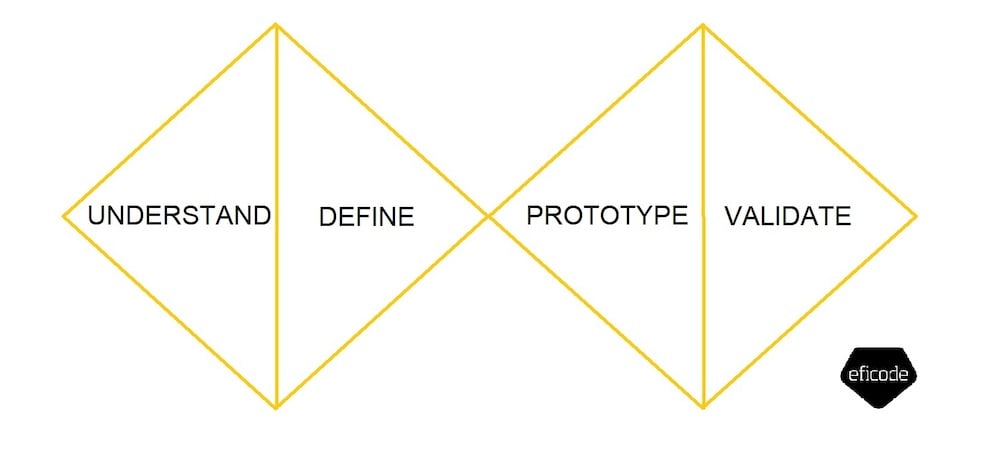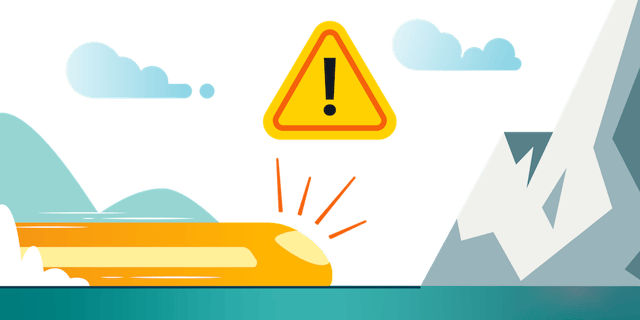You are on a high-speed train heading straight towards a towering cliff – or that’s how you feel. And what’s worse: your client is driving the train.
A scenario like this is a familiar consultant’s dilemma. But how did you end up in such a situation? And what can you do to save the project?
To get to the solution, know the problem
Sometimes there is such a dire need for the solution that one wishes to jump straight to it.
I call this going to the finish line without passing first through start. It is natural for the human adult brain to look for a solution automatically. Our brains are so obsessed and filled with data, knowledge, and experience that we intuitively believe we already have all the tools and information to crack the case.
What case, may I ask? Do we really have all the needed data, knowledge, and experience about the case to begin with? Often, we do not.
Double Triple Diamond to the rescue
You’ve got to love service design as a guide for this type of thinking. The commonly used Double Diamond framework separates creativity from conclusions and guides you on the way from exploring an issue more widely or deeply (divergent thinking) to taking focused action (convergent thinking).

Following the same kind of thinking in a design sprint, ideation is carried out on a different day from deciding which idea to carry forward. Unbiased mind free from assumptions can wander wildly and come up with new ideas and points of view. All ideas are welcome and equal at this point. Only on the following day one is ready to evaluate, prioritize and make sense out of ideas to sketch towards the solution. Think how often your brilliant idea at night appears less feasible in the morning. Yet, the idea itself had a seed of magnificence.
Trying to solve a problem while still figuring out what it really is, is impossible and certain to fail. This has been realized also in many service design cases. Oftentimes, many service design projects, including productized design sprints, start with gathering customer/user data. From this data we can find valuable insights that define the challenge that needs to be solved. The need for customer insights is depicted in a Triple Diamond.

(Maybe) we know the solution, but the path to it is unclear
I was recently involved in a project in which everybody knew the desired outcome. Our assignment, however, was to define that outcome.
We were puzzled for too long a time (I admit), trying to figure out what was expected from us. Surely we could not simply provide a single button, the desired outcome, as the panacea to the client’s headache. It would have been the same button that anyone could have suggested. We were numb, unable to get going. How to suggest something that was too obviously the solution?
Little by little, we guided the customer to see the actual need for our work: to create the “magical single button” solution. We needed to show the client the path required to get to the solution. Our task was to define the journey starting from the root problem(s) through use cases, not just to apply a given tool. We needed data to define the problem(s) that led to the desired solution.
As the project the customer had asked from us did not appear feasible, the perspective and attitude of the assignment had to be redefined, and the customer’s expectations set right.
It is always an arduous task for a consultant to steer the customer to a better path. Yet, it is the duty of the consultant to ensure the best outcome for the client. Nobody wants to do a project in vain.
Thankfully, this particular client was receptive, and all went well.
When the case reminds you of a spider’s web, get your spindle out
So you are looking for a needle in a haystack or feeling like you are caught in a spider’s web, or walking on thin ice. How can you make measurements when the tools you have do not fit the magnitude of the phenomenon you are trying to figure out?
In such a situation, any pre-given tool may give you an answer to a wrong problem. The project or process often ends up being too feeble or narrow. We are every now and then asked to run e.g. a design sprint, because the client has heard it works wonders. Yet, it is the wrong method for the particular client and case. Or, we are asked to run accessibility tests but at the start, we realize usability must be fixed first. In these cases, we look for consensus with the client for next steps.
To untangle the spider’s web, one should understand the big picture and look for the regularities, repetitions, similarities, i.e., the obvious. To see the obvious, look afar.
Only after having defined what kind of a case lies ahead, should you decide on the tools and methods to start the next phase. Start by probing a few essential use cases and expand the insights wider in due time. Ethnographic methods are helpful in finding the needle in the haystack in a budget-friendly and effective manner.
I have conducted several team and organization assessments using ethnography (interviews, observation, etc.) to find the root causes to be developed. Ethnography deals with what happens emotionally and physically between people and sometimes the issues that come up, are difficult for the client to accept. One time our data was very clear on the problem, which the client denied. But after our project was done, they fixed it. Happy end, after all.
Still lost at sea?
It is common that organizations and teams have a vague idea of what is wrong but can’t verbalize it into something concrete. An outsider’s view is valuable to make the unseen seen.
This is what we consultants do, but we should begin from the first principles by comprehending the problem and the challenges before rushing forward. My advice is that if the sea appears dark and unexplored and icebergs are evident, start by looking for the essentials, the similarities, and the repetitions to find the obvious.
I guarantee you – customer, consultant, whoever you are - will find the sailing much smoother and sail to a harbor of happiness if you follow this process.
Published: Jun 21, 2022

